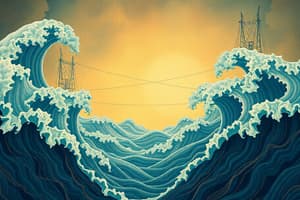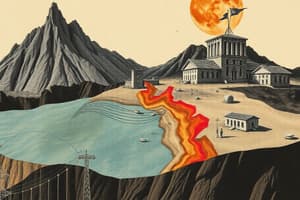Podcast
Questions and Answers
What are earthquakes primarily caused by?
What are earthquakes primarily caused by?
- The gravitational pull of the moon
- Changes in atmospheric pressure
- The movement of plates at fault lines (correct)
- Erosion from wind and rain
What is a fault in the context of earthquakes?
What is a fault in the context of earthquakes?
- A mountain formed by volcanic activity
- The point inside Earth where an earthquake starts
- Break in Earth’s lithosphere where one block of rock moves (correct)
- A type of seismic wave
Which type of plate boundary is typically associated with strike-slip faults?
Which type of plate boundary is typically associated with strike-slip faults?
- Convergent plate boundaries
- All plate boundaries
- Divergent plate boundaries
- Transform plate boundaries (correct)
What is the focus of an earthquake?
What is the focus of an earthquake?
Which type of seismic wave cannot travel through liquids?
Which type of seismic wave cannot travel through liquids?
Flashcards
Earthquake
Earthquake
Vibrations in the Earth’s ground due to the movement of plates at fault lines.
Fault
Fault
A break in Earth’s lithosphere where one block of rock moves toward, away from, or past another.
Seismic Waves
Seismic Waves
Energy that travels as vibrations on and in Earth.
Focus
Focus
Signup and view all the flashcards
Epicenter
Epicenter
Signup and view all the flashcards
Study Notes
Earthquakes
- Earthquakes are vibrations in the Earth's ground caused by the movement of plates at fault lines
- Most earthquakes occur along plate boundaries
Faults
- Faults refer to a break in the Earth's lithosphere where a block of rock moves
Types of Faults
- Strike-Slip Faults occur at transform plate boundaries
- Normal Faults occur at divergent plate boundaries
- Reverse Faults occur at convergent plate boundaries
Earthquakes, Focus, and Epicenter
- Seismic waves are energy that travels as vibrations on/ in earth
- The focus is the point inside the Earth where an earthquake starts
- The epicenter is the location on the Earth's surface directly above the focus
Types of Seismic Waves
- Primary Waves (P-Waves) travel in a push/pull motion and are the fastest seismic waves, being able to travel through solids and liquids
- Secondary waves (S-Waves) travel slower than P-waves, traveling only through solids with particles moving in an up and down motion
- Surface waves move in a rolling motion as the slowest seismic wave, which causes extensive damage
Earth's Interior
- Scientists found the Earth's outer core is liquid because S-Waves can't travel through liquids, while P-Waves can travel through solids and liquids
Finding an Epicenter
- To find the epicenter, find the difference between the arrival time of the P-wave and S-wave to give the lag time
- Use an earthquake distance graph to determine the distance from the epicenter
- Draw a circle with the measured correct distance around the station, repeating for two more stations
- Where the circles intersect marks the epicenter
Measuring Earthquakes
- The Richter Scale measures the amount of motion at a given distance
- The Moment Magnitude Scale measures the total energy released by an earthquake
- The Modified Mercalli Scale measure the intensity of an earthquake from I-XII, based on the amount of damage
Earthquake Risk
- Seismologists use 5 indicators to assess earthquake risk: includes past earthquakes, probability, population density, geology around a fault, and building design
Volcanoes
- A volcano is a vent in the Earth's crust through which molten rock flows
Where Volcanoes Form
- Convergent boundaries cause volcanoes when two plates collide, causing one plate to subduct under another plate
- Divergent boundaries cause volcanoes when two plates separate, allowing magma comes out
- Hot spots that are not associated with plate boundaries can form volcanoes, and usually form chains of islands, like Hawaii
Types of Volcanoes
- Shield Volcanoes are large, shield-shaped volcanoes with gentle slopes and eruptions
- Composite Volcanoes are large, steep-sided volcanoes that result from explosive eruptions
- Cinder Cone Volcanoes are smalls, steep-sided volcanoes that erupt gas-rich based basaltic lavas, creating moderate explosions
Caldera
- A caldera is a large volcanic depression created when the summit of a volcano collapses following a violent eruption
Types of Eruptions
- Violent eruptions exhibit high viscosity and gas content lavas
- Quiet eruptions have low viscosity and low gas content lavas
Effects of Volcanic Eruptions
- Lava flows move slowly and can destroy towns, but are rarely deadly
- Ash fall can causes breathing problems, cool the Earth's atmosphere, and disrupt air traffic
- Mudflows can cause snow and ice to melt, mixing with mud/ash and causing significant mudflows
- Pyroclastic flows can be deadly when produced from eruptions that throw gas, ash, and rock into the air
Predicting Volcanoes
- Volcanoes are predicted through ground deformation, an increase in earthquakes, increasing volcanic gases, and increased acidity of water nearby
Climate
- Volcanic ash can block sunlight and cause a decrease in global temperatures
- Volcanic activity may also result in acid rain
Studying That Suits You
Use AI to generate personalized quizzes and flashcards to suit your learning preferences.




